2014 NISSAN ALTIMA steering wheel
[x] Cancel search: steering wheelPage 350 of 428
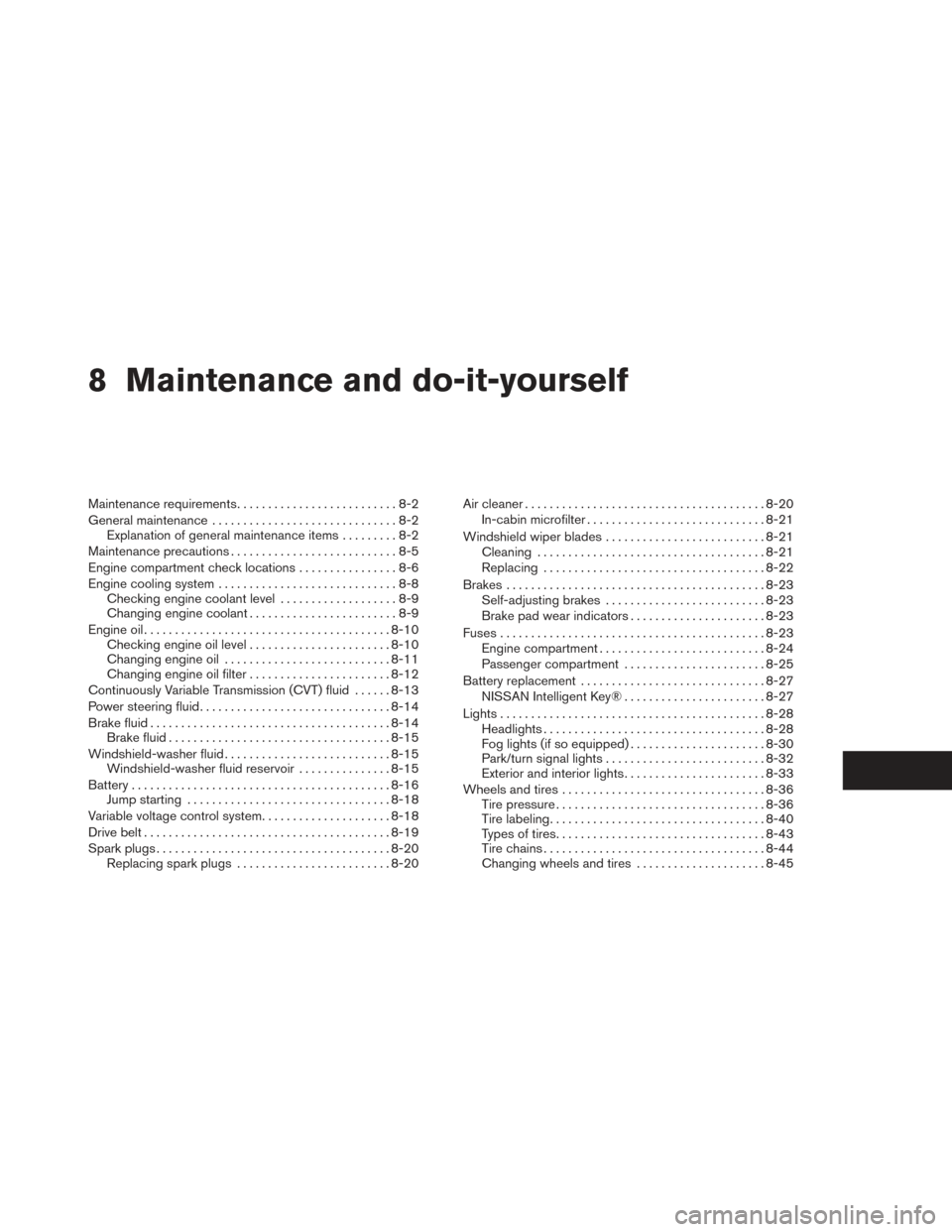
8 Maintenance and do-it-yourself
Maintenance requirements..........................8-2
General maintenance ..............................8-2
Explanation of general maintenance items .........8-2
Maintenance precautions ...........................8-5
Engine compartment check locations ................8-6
Engine cooling system .............................8-8
Checking engine coolant level ...................8-9
Changing engine coolant ........................8-9
Engine oil ........................................ 8-10
Checking engine oil level .......................8-10
Changing engine oil ........................... 8-11
Changing engine oil filter .......................8-12
Continuously Variable Transmission (CVT) fluid ......8-13
Power steering fluid ............................... 8-14
Brake fluid ....................................... 8-14
Brake fluid .................................... 8-15
Windshield-washer fluid ........................... 8-15
Windshield-washer fluid reservoir ...............8-15
Battery .......................................... 8-16
Jump starting ................................. 8-18
Variable voltage control system .....................8-18
Drive belt ........................................ 8-19
Spark plugs ...................................... 8-20
Replacing spark plugs ......................... 8-20Air cleaner
....................................... 8-20
In-cabin microfilter ............................. 8-21
Windshield wiper blades .......................... 8-21
Cleaning ..................................... 8-21
Replacing .................................... 8-22
Brakes .......................................... 8-23
Self-adjusting brakes .......................... 8-23
Brake pad wear indicators ......................8-23
Fuses ........................................... 8-23
Engine compartment ........................... 8-24
Passenger compartment .......................8-25
Battery replacement .............................. 8-27
NISSAN Intelligent Key® .......................8-27
Lights ........................................... 8-28
Headlights .................................... 8-28
Fog
lights (if so equipped) ...................... 8-30
Park/turn signal lights .......................... 8-32
Exterior and interior lights .......................8-33
Wheels and tires ................................. 8-36
Tire pressure . . . ............................... 8-36
Tire labeling ................................... 8-40
Types of tires .................................. 8-43
Tire chains .................................... 8-44
Changing wheels and tires .....................8-45
Page 352 of 428
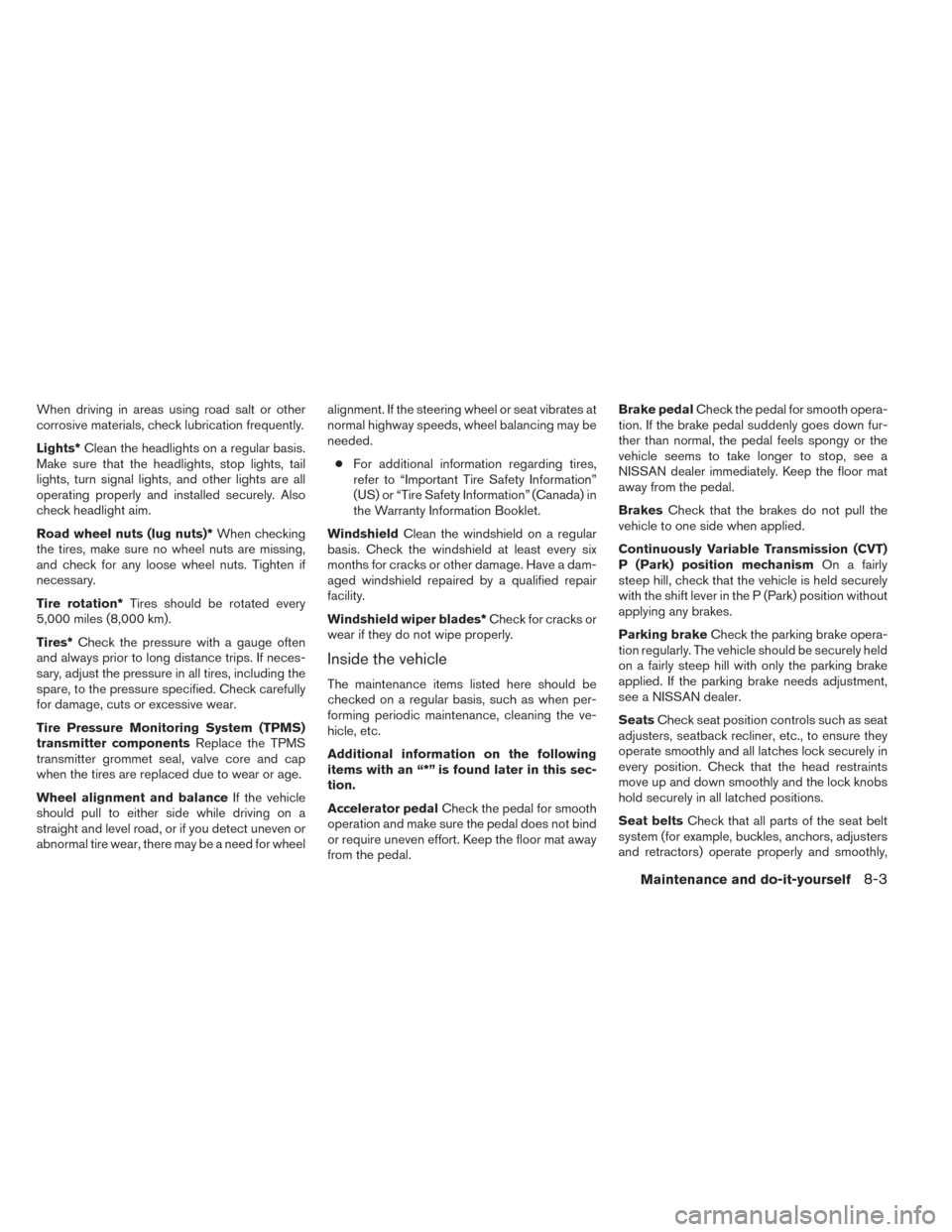
When driving in areas using road salt or other
corrosive materials, check lubrication frequently.
Lights*Clean the headlights on a regular basis.
Make sure that the headlights, stop lights, tail
lights, turn signal lights, and other lights are all
operating properly and installed securely. Also
check headlight aim.
Road wheel nuts (lug nuts)* When checking
the tires, make sure no wheel nuts are missing,
and check for any loose wheel nuts. Tighten if
necessary.
Tire rotation* Tires should be rotated every
5,000 miles (8,000 km).
Tires* Check the pressure with a gauge often
and always prior to long distance trips. If neces-
sary, adjust the pressure in all tires, including the
spare, to the pressure specified. Check carefully
for damage, cuts or excessive wear.
Tire Pressure Monitoring System (TPMS)
transmitter components Replace the TPMS
transmitter grommet seal, valve core and cap
when the tires are replaced due to wear or age.
Wheel alignment and balance If the vehicle
should pull to either side while driving on a
straight and level road, or if you detect uneven or
abnormal tire wear, there may be a need for wheel alignment. If the steering wheel or seat vibrates at
normal highway speeds, wheel balancing may be
needed.
● For additional information regarding tires,
refer to “Important Tire Safety Information”
(US) or “Tire Safety Information” (Canada) in
the Warranty Information Booklet.
Windshield Clean the windshield on a regular
basis. Check the windshield at least every six
months for cracks or other damage. Have a dam-
aged windshield repaired by a qualified repair
facility.
Windshield wiper blades* Check for cracks or
wear if they do not wipe properly.
Inside the vehicle
The maintenance items listed here should be
checked on a regular basis, such as when per-
forming periodic maintenance, cleaning the ve-
hicle, etc.
Additional information on the following
items with an “*” is found later in this sec-
tion.
Accelerator pedal Check the pedal for smooth
operation and make sure the pedal does not bind
or require uneven effort. Keep the floor mat away
from the pedal. Brake pedal
Check the pedal for smooth opera-
tion. If the brake pedal suddenly goes down fur-
ther than normal, the pedal feels spongy or the
vehicle seems to take longer to stop, see a
NISSAN dealer immediately. Keep the floor mat
away from the pedal.
Brakes Check that the brakes do not pull the
vehicle to one side when applied.
Continuously Variable Transmission (CVT)
P (Park) position mechanism On a fairly
steep hill, check that the vehicle is held securely
with the shift lever in the P (Park) position without
applying any brakes.
Parking brake Check the parking brake opera-
tion regularly. The vehicle should be securely held
on a fairly steep hill with only the parking brake
applied. If the parking brake needs adjustment,
see a NISSAN dealer.
Seats Check seat position controls such as seat
adjusters, seatback recliner, etc., to ensure they
operate smoothly and all latches lock securely in
every position. Check that the head restraints
move up and down smoothly and the lock knobs
hold securely in all latched positions.
Seat belts Check that all parts of the seat belt
system (for example, buckles, anchors, adjusters
and retractors) operate properly and smoothly,
Maintenance and do-it-yourself8-3
Page 353 of 428
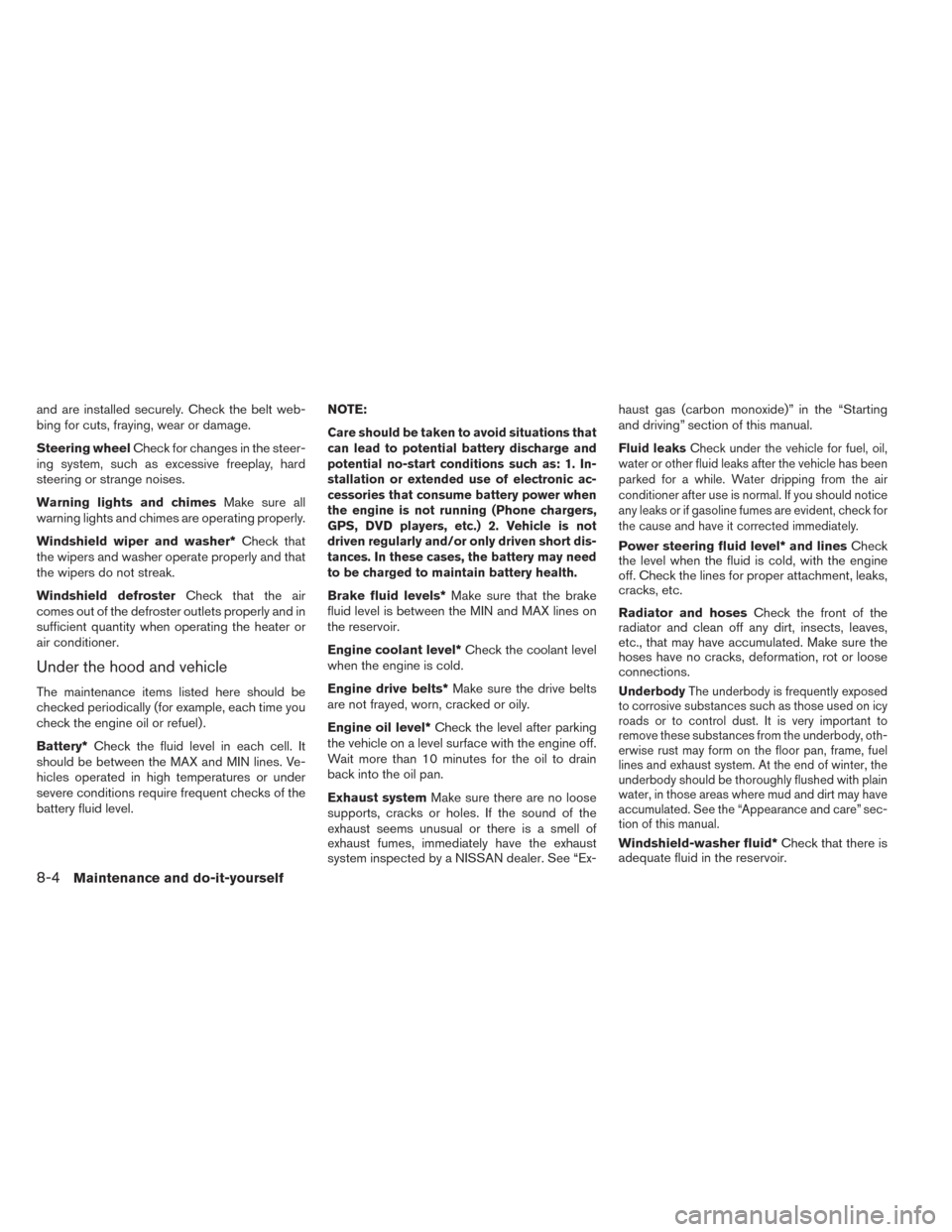
and are installed securely. Check the belt web-
bing for cuts, fraying, wear or damage.
Steering wheelCheck for changes in the steer-
ing system, such as excessive freeplay, hard
steering or strange noises.
Warning lights and chimes Make sure all
warning lights and chimes are operating properly.
Windshield wiper and washer* Check that
the wipers and washer operate properly and that
the wipers do not streak.
Windshield defroster Check that the air
comes out of the defroster outlets properly and in
sufficient quantity when operating the heater or
air conditioner.
Under the hood and vehicle
The maintenance items listed here should be
checked periodically (for example, each time you
check the engine oil or refuel) .
Battery* Check the fluid level in each cell. It
should be between the MAX and MIN lines. Ve-
hicles operated in high temperatures or under
severe conditions require frequent checks of the
battery fluid level. NOTE:
Care should be taken to avoid situations that
can lead to potential battery discharge and
potential no-start conditions such as: 1. In-
stallation or extended use of electronic ac-
cessories that consume battery power when
the engine is not running (Phone chargers,
GPS, DVD players, etc.) 2. Vehicle is not
driven regularly and/or only driven short dis-
tances. In these cases, the battery may need
to be charged to maintain battery health.
Brake fluid levels*
Make sure that the brake
fluid level is between the MIN and MAX lines on
the reservoir.
Engine coolant level* Check the coolant level
when the engine is cold.
Engine drive belts* Make sure the drive belts
are not frayed, worn, cracked or oily.
Engine oil level* Check the level after parking
the vehicle on a level surface with the engine off.
Wait more than 10 minutes for the oil to drain
back into the oil pan.
Exhaust system Make sure there are no loose
supports, cracks or holes. If the sound of the
exhaust seems unusual or there is a smell of
exhaust fumes, immediately have the exhaust
system inspected by a NISSAN dealer. See “Ex- haust gas (carbon monoxide)” in the “Starting
and driving” section of this manual.
Fluid leaks
Check under the vehicle for fuel, oil,
water or other fluid leaks after the vehicle has been
parked for a while. Water dripping from the air
conditioner after use is normal. If you should notice
any leaks or if gasoline fumes are evident, check for
the cause and have it corrected immediately.
Power steering fluid level* and lines Check
the level when the fluid is cold, with the engine
off. Check the lines for proper attachment, leaks,
cracks, etc.
Radiator and hoses Check the front of the
radiator and clean off any dirt, insects, leaves,
etc., that may have accumulated. Make sure the
hoses have no cracks, deformation, rot or loose
connections.
Underbody The underbody is frequently exposed
to corrosive substances such as those used on icy
roads or to control dust. It is very important to
remove these substances from the underbody, oth-
erwise rust may form on the floor pan, frame, fuel
lines and exhaust system. At the end of winter, the
underbody should be thoroughly flushed with plain
water, in those areas where mud and dirt may have
accumulated. See the “Appearance and care” sec-
tion of this manual.
Windshield-washer fluid* Check that there is
adequate fluid in the reservoir.
8-4Maintenance and do-it-yourself
Page 422 of 428
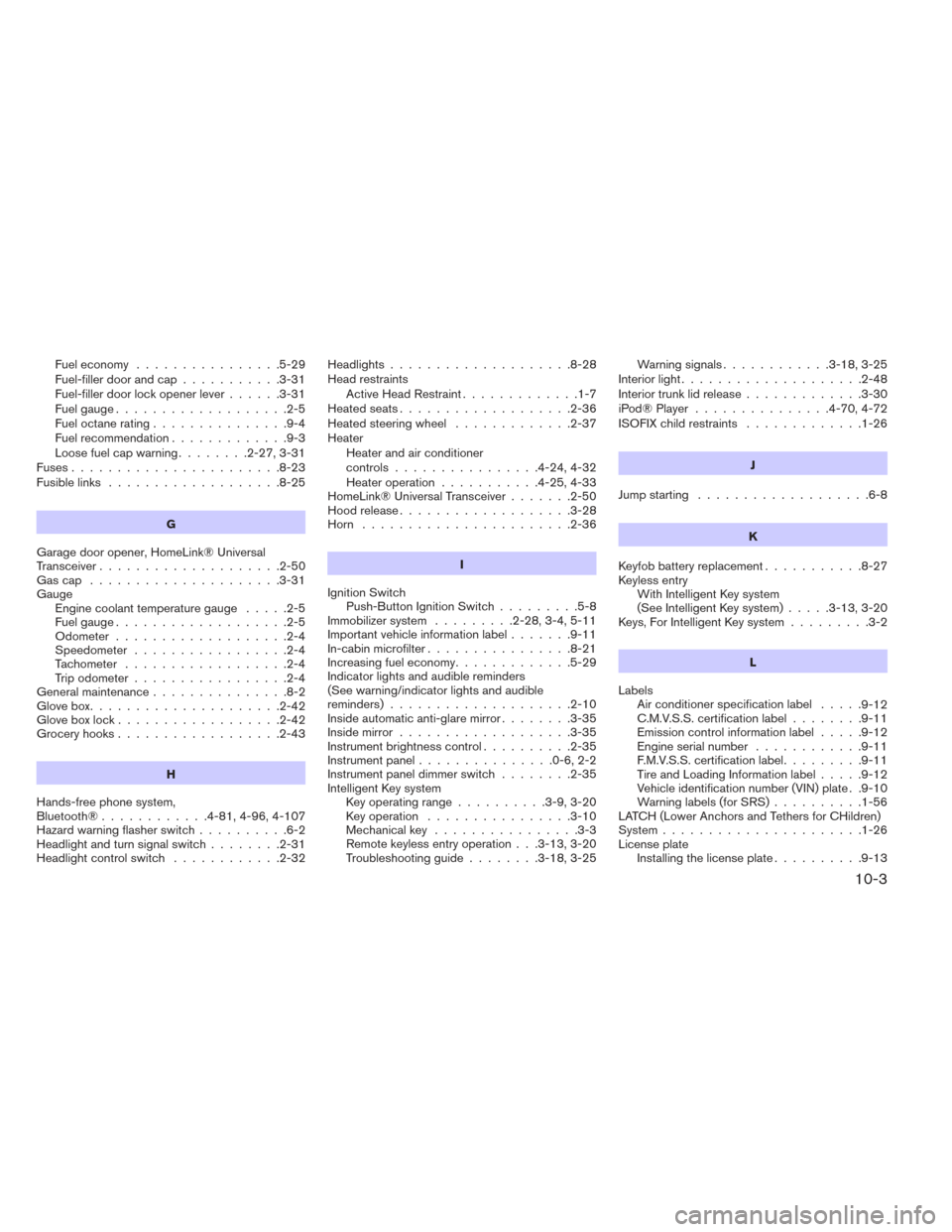
Fuel economy................5-29
Fuel-filler door and cap ...........3-31
Fuel-filler door lock opener lever ......3-31
Fuel gauge ...................2-5
Fueloctanerating...............9-4
Fuel recommendation .............9-3
Loosefuelcapwarning........2-27,3-31
Fuses.......................8-23
Fusiblelinks ...................8-25
G
Garage door opener, HomeLink® Universal
Transceiver....................2-50
Gascap .....................3-31
Gauge Engine coolant temperature gauge .....2-5
Fuel gauge ...................2-5
Odometer ...................2-4
Speedometer .................2-4
Tachometer ..................2-4
Trip odometer .................2-4
Generalmaintenance...............8-2
Glovebox.....................2-42
Gloveboxlock..................2-42
Grocery hooks ..................2-43
H
Hands-free phone system,
Bluetooth®............4-81,4-96,4-107
Hazard warning flasher switch ..........6-2
Headlightandturnsignalswitch........2-31
Headlightcontrolswitch ............2-32 Headlights
....................8-28
Head restraints Active Head Restraint .............1-7
Heated seats ...................2-36
Heated steering wheel .............2-37
Heater Heater and air conditioner
controls................4-24,4-32
Heater operation ...........4-25,4-33
HomeLink® Universal Transceiver .......2-50
Hood release ...................3-28
Horn .......................2-36
I
Ignition Switch Push-Button Ignition Switch .........5-8
Immobilizer system .........2-28,3-4,5-11
Important vehicle information label .......9-11
In-cabin microfilter ................8-21
Increasing fuel economy .............5-29
Indicator lights and audible reminders
(See warning/indicator lights and audible
reminders)....................2-10
Inside automatic anti-glare mirror ........3-35
Inside mirror ...................3-35
Instrument brightness control ..........2-35
Instrument panel ...............0-6,2-2
Instrument panel dimmer switch ........2-35
Intelligent Key system Key operating range ..........3-9,3-20
Key operation ................3-10
Mechanicalkey ................3-3
Remote keyless entry operation . . .3-13, 3-20
Troubleshooting guide ........3-18,3-25 Warning signals
............3-18,3-25
Interiorlight....................2-48
Interior trunk lid release .............3-30
iPod® Player ...............4-70,4-72
ISOFIX child restraints .............1-26
J
Jump starting ...................6-8
K
Keyfob battery replacement ...........8-27
Keyless entry With Intelligent Key system
(See Intelligent Key system) .....3-13,3-20
Keys, For Intelligent Key system .........3-2
L
Labels Air conditioner specification label .....
9-12
C.M.V.S.S. certification label ........9-11
Emission control information label .....9-12
Engine serial number ............9-11
F.M.V.S.S. certification label .........9-11
Tire and Loading Information label .....9-12
Vehicle identification number (VIN) plate . .9-10
Warning labels (for SRS) ..........1-56
LATCH (Lower Anchors and Tethers for CHildren)
System ......................1-26
License plate Installing the license plate ..........9-13
10-3
Page 424 of 428
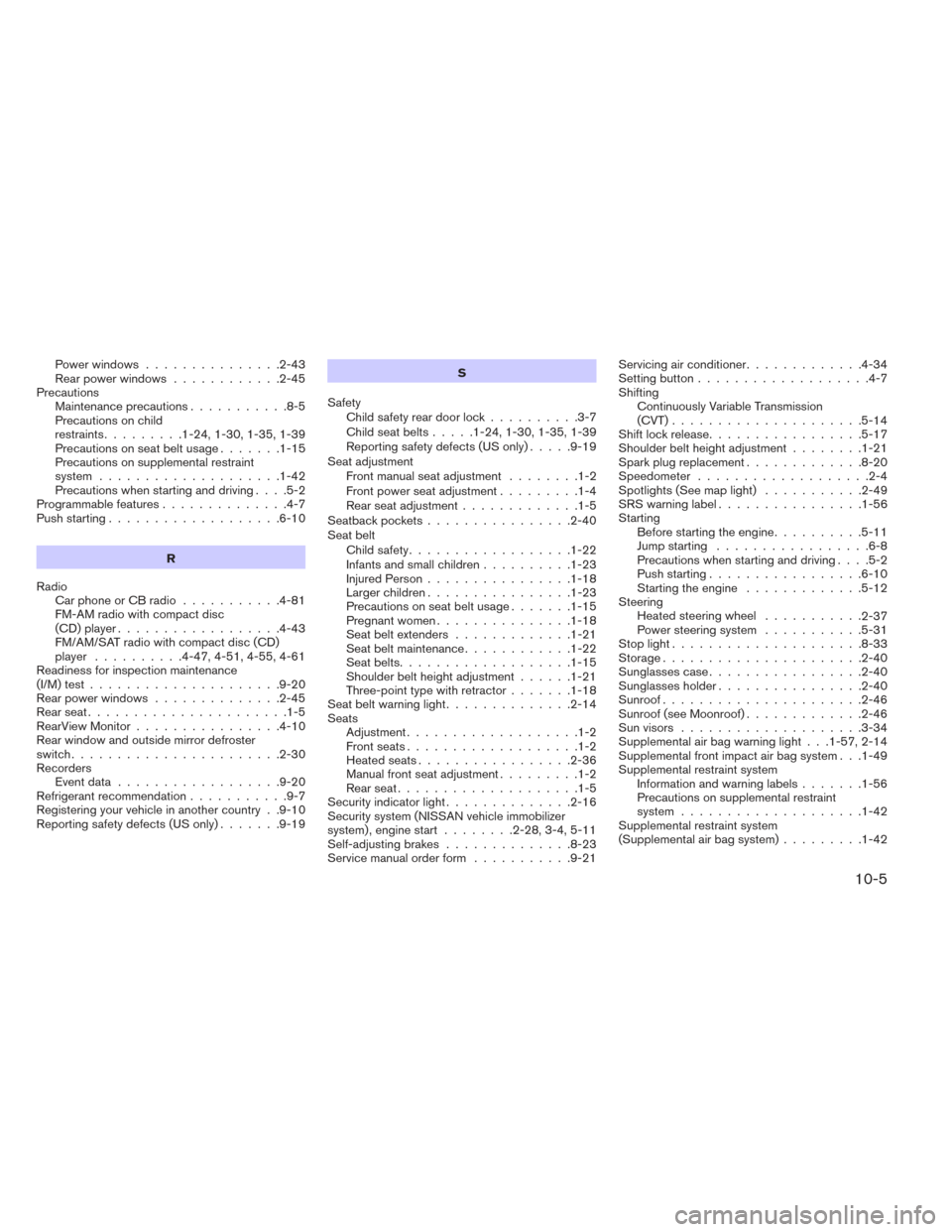
Power windows...............2-43
Rear power windows ............2-45
Precautions Maintenanceprecautions...........8-5
Precautions on child
restraints .........1-24,1-30,1-35,1-39
Precautionsonseatbeltusage.......1-15
Precautions on supplemental restraint
system ....................1-42
Precautions when starting and driving ....5-2
Programmable features ..............4-7
Push starting ...................6-10
R
Radio Car phone or CB radio ...........4-81
FM-AM radio with compact disc
(CD) player ..................4-43
FM/AM/SAT radio with compact disc (CD)
player ..........4-47,4-51,4-55,4-61
Readiness for inspection maintenance
(I/M) test .....................9-20
Rear power windows ..............2-45
Rearseat......................1-5
RearViewMonitor................4-10
Rear window and outside mirror defroster
switch .......................2-30
Recorders Eventdata..................9-20
Refrigerant recommendation ...........9-7
Registering your vehicle in another country . .9-10
Reporting safety defects (US only) .......9-19 S
Safety Child safety rear door lock ..........3-7
Childseatbelts.....1-24,1-30,1-35,1-39
Reporting safety defects (US only) .....9-19
Seat adjustment Frontmanualseatadjustment ........1-2
Front power seat adjustment .........1-4
Rear seat adjustment .............1-5
Seatback pockets ................2-40
Seat belt Child safety ..................1-22
Infants and small children ..........1-23
Injured Person ................1-18
Largerchildren................1-23
Precautions on seat belt usage .......1-15
Pregnant women ...............1-18
Seatbeltextenders .............1-21
Seatbeltmaintenance............1-22
Seatbelts...................1-15
Shoulder belt height adjustment ......1-21
Three-point type with retractor .......1-18
Seat belt warning light ..............2-14
Seats Adjustment ...................1-2
Frontseats...................1-2
Heatedseats.................2-36
Manual front seat adjustment .........1-2
Rearseat....................1-5
Security indicator light ..............2-16
Security system (NISSAN vehicle immobilizer
system) , engine start ........2-28,3-4,5-11
Self-adjusting brakes ..............8-23
Service manual order form ...........9-21Servicing air conditioner
.............4-34
Setting button ...................4-7
Shifting Continuously Variable Transmission
(CVT) .....................5-14
Shiftlockrelease.................5-17
Shoulder belt height adjustment ........1-21
Spark plug replacement .............8-20
Speedometer ...................2-4
Spotlights(Seemaplight) ...........2-49
SRSwarninglabel................1-56
Starting Before starting the engine ..........5-11
Jump starting .................6-8
Precautions when starting and driving ....5-2
Push starting .................6-10
Starting the engine .............5-12
Steering Heated steering wheel ...........
2-37
Power steering system ...........5-31
Stoplight.....................8-33
Storage......................2-40
Sunglasses case .................2-40
Sunglasses holder ................2-40
Sunroof ......................2-46
Sunroof (see Moonroof) .............2-46
Sun visors ....................3-34
Supplemental air bag warning light . . .1-57, 2-14
Supplemental front impact air bag system . . .1-49
Supplemental restraint system Information and warning labels .......1-56
Precautions on supplemental restraint
system ....................1-42
Supplemental restraint system
(Supplemental air bag system) .........1-42
10-5